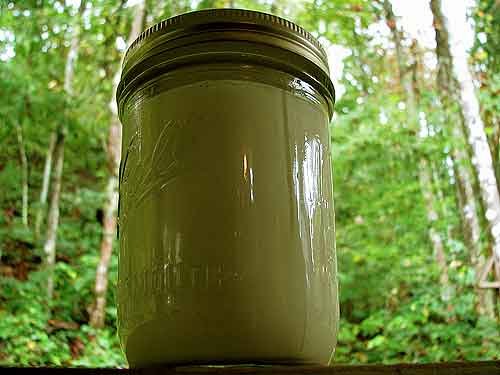
Fresh milk. It’s an amazing thing. Goat milk is sweet and rich, perfect for cheese and baking and anything else for which you would use store-bought milk. And you made it yourself–you and your goat. But if you’ve never milked before, how to handle milk properly can be a bit of mystery. I know it was for me. I read the books. I researched online. And what I wished I had were pictures. I’m a visual learner. I want pictures.
And so this post is for those of you who are either thinking about milking at home sometime in the future, preparing to milk sometime soon, or just plain curious even if you never intend to milk anything. Note: If you are preparing to milk at home–I am not an expert and I don’t play one on the internet. Please consult expert sources such as Storey’s Guide to Raising Dairy Goats, Raising Milk Goats Successfully, and the Fias Co Farm website. This post is not intended to be a how-to guide. Rather, it is intended to be an accompaniment in pictures to expert sources such as those I’ve listed. (If you have arrived at this post via a search engine at some later date from its posting, please also read the comments to this post as I have high hopes there will be great advice in there as well from far more experienced milkers than me.)
What you will need–
*a stainless steel milking pail
*a strainer
*milk filters
*bleach
*dishwashing liquid
*small stainless steel bowl for the udder wash
*teat dip cup
*some sort of strip cup
*paper towels
*water
*containers to hold your filtered milk (glass preferable)
I relied most heavily in my decision-making regarding milk handling on the Fias Co Farm site as I found it to be the most practical, with consideration of other information from books. However, the writers of that site were milking quite a number of full-sized goats. I am milking one small Nigerian Dwarf doe. I downsized the Fias Co Farm instructions for the amount of milk I would be handling and the practical considerations of milking one small goat.
Each morning, when I prepare to milk Clover, I assemble my equipment, starting with the small bowl and cup I use for the udder wash and teat dip.
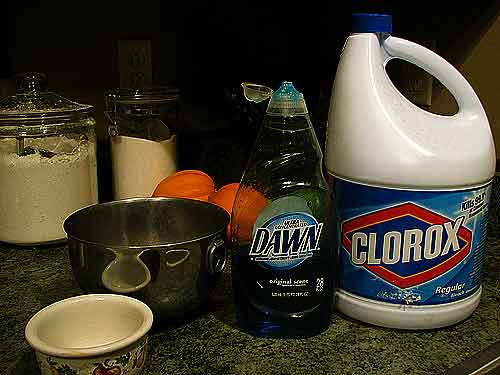
I use Clorox bleach and Dawn original blue dishwashing liquid for the udder wash and teat dip. I do not measure. (Consult the Fias Co Farm site for her measurement instructions.) I don’t measure because I’m dealing with one small doe and one small bowl. I drop a small splash of bleach in the stainless steel bowl, followed by a drop of Dawn.
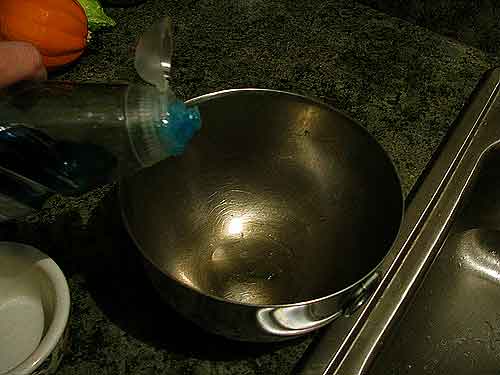
I place the bowl under hot running water, then place the small teat dip cup in there to carry out to the milkstand.

Next I drop a larger splash of bleach into the milking pail in the sink and run hot water into the pail.
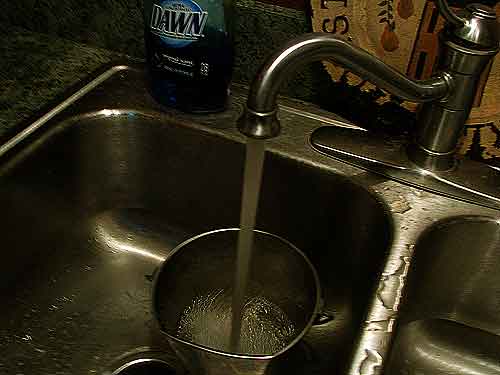
The Fias Co Farm site recommends filling the sink with hot water and bleach and immersing the pail. I find this far too wasteful of water and bleach for my purposes with one small pail. I just set the pail in the sink with that splash of bleach and fill it with hot water. I let it sit for a couple of minutes, then I pour some of the bleach water over the strainer to sanitize the strainer.
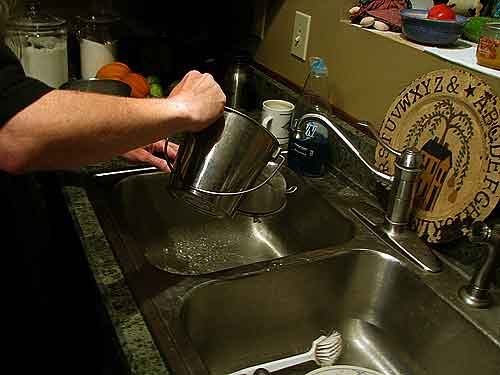
I set the strainer on a clean paper towel and pour out the rest of the water from the pail, slowly, turning the pail as I do so that the bleach water pours out over every inch of the pail’s rim. I dry the pail inside with a paper towel, then fold up a couple more fresh paper towels to take down to the milkstand with me and tuck them inside the pail.
To the milkstand, I carry my bowl of udder wash (with the teat dip cup nested inside) and my milking pail (clean paper towels tucked within).
Note: While I use the Fias Co Farm site’s solution for udder wash and teat dip, I’ve also seen recommendations including a vinegar solution as well as simply using alcohol-free baby wipes. Take your pick.
Once in the milking pen, I remove the teat dip cup from the larger udder wash bowl, making sure the teat dip cup is filled, and set it aside.
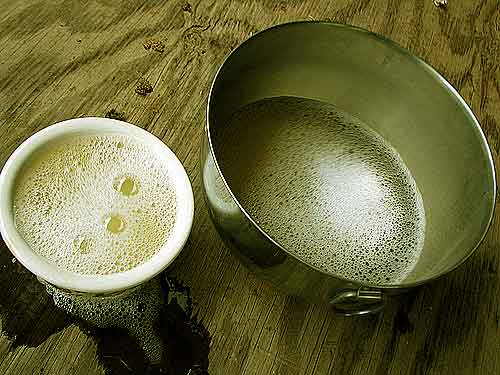
I soak a paper towel with the udder wash solution and wash Clover’s entire udder area, drying it with another paper towel.

I dip my own hands in the remaining udder wash solution. I wash my hands throughout this entire process when I am in the kitchen, but once I’m in the milking pen, I don’t have access to a sink and I have already touched several things, so I sanitize my hands again by dipping them in the udder wash. 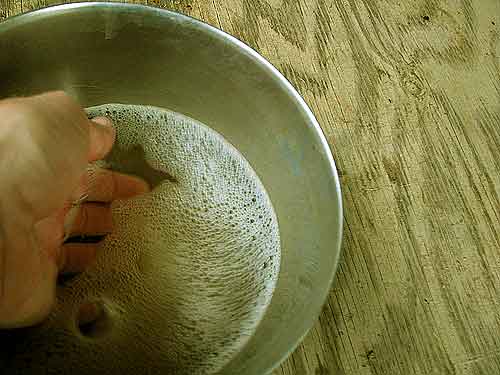
I use another paper towel to dry my hands and then I place that paper towel on the handle of the feed container. I will feed Clover several times during milking and I don’t want to directly touch the feed container again after my hands are sanitized.
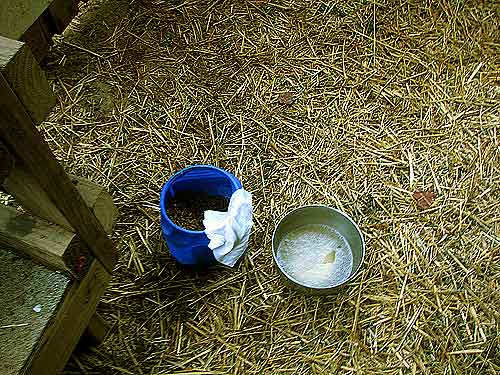
Using your strip cup, draw out the first few squirts. The first few squirts contain bacteria that has collected in the teat and should be eliminated. It also allows you to check the milk for any abnormalities, which helps you keep an eye on your goat’s health and her milk. Then I set the strip cup aside to milk my lovely Clover and tell her how pretty she is. And she tells me how many cookies she wants for this daily violation of her person, but that is another story.
When I’m finished, I set the pail aside and pick up the teat dip. I dip her teats, scratch her behind the ears, and set her free.
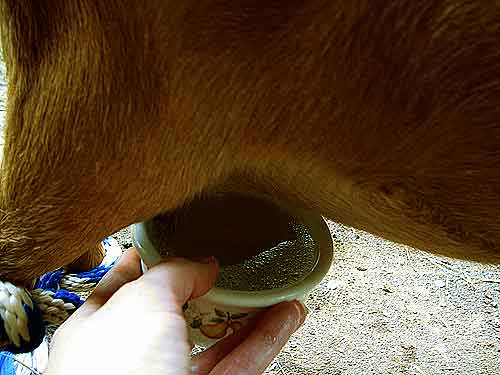
I take the milk pail to the kitchen immediately. When milk leaves the udder, it is at 100 degrees. Ideally, it should be chilled to 38 degrees within one hour.
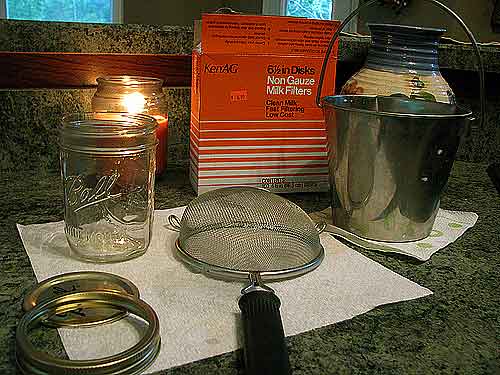
Before chilling the milk, I wash my hands then take out a fresh milk filter. Milk filters (available at farm supply stores) are somewhat similar to coffee filters, but not exactly. Get real milk filters. Don’t use coffee filters.
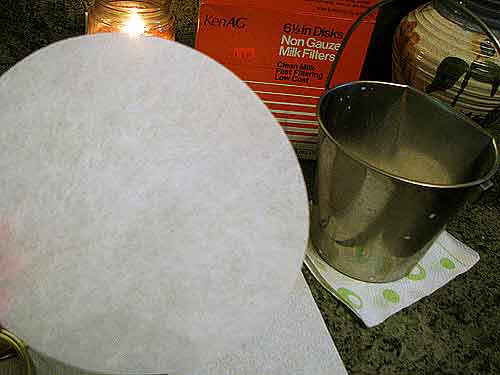
I place a milk filter inside the strainer.
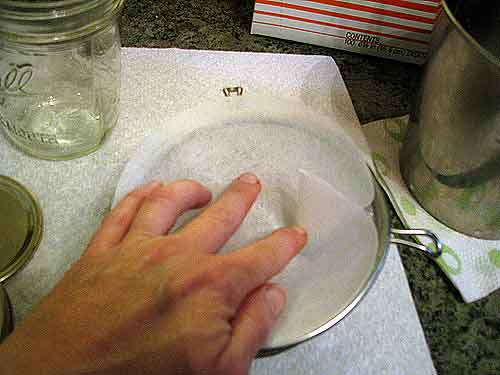
Then I slowly pour the milk from the pail into the filtered strainer.

I use glass pint jars because I get a pint of milk from Clover per milking. I immediately place the pint jar in the freezer. Other ways to chill milk rapidly include placing the milk inside a bowl of ice water in the refrigerator or even specialized milk cooling equipment (for the extensive home dairy!). I find placing the pint jar in the freezer the simplest method for me, with my one pint of milk and my one little goat.

Wow, my freezer is a mess!
I leave about an inch of head space and even if I forget and leave the milk in there all day, it doesn’t blow up. I try to remember to take the jar out after about an hour. Then I place it in the fridge and it’s ready for baking or other uses.
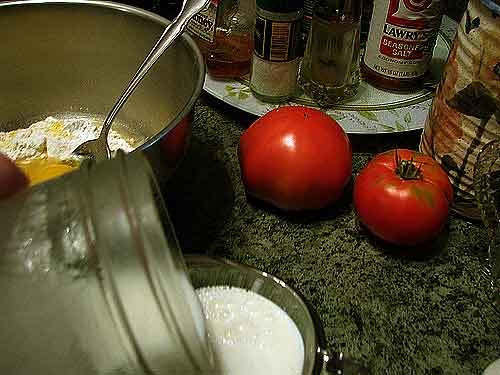
If I’m saving milk up or have more than I can use, I pour the chilled milk into a plastic freezer bag. Fresh milk can be stored in the refrigerator for a week or in the freezer for up to a year.

To pasteurize milk, heat it to 165 degrees for 15 seconds. (Do not use a microwave.) I do not pasteurize. I prefer to use raw milk. Raw milk vs. pasteurized milk is a weightier topic than I can explore, but in short, pasteurization, or heat-treating milk, was developed to protect the public from the potential of unsafe milk. FYI, it is illegal to sell raw milk in the United States. (Correction: This is true in most states, but not all. Thank you, Amy!) However, it is considered by many to be healthier and tastier than pasteurized milk, and the use of raw milk is widely practiced by home milkers (as it was by our grannies) who know their sanitation procedures, their goat’s health, and how swiftly they will store and use their milk. Please consult expert sources to make your own decisions if you are planning to milk at home.
After I’ve stored my milk properly, the milk pail is rinsed in cool water and wiped out, then the pail and other equipment goes straight into the dishwasher–from whence it will emerge the next morning, ready to be further sanitized and taken to the milking pen again. And every day, there is Clover, ready with a fresh supply of her sweet, rich milk.
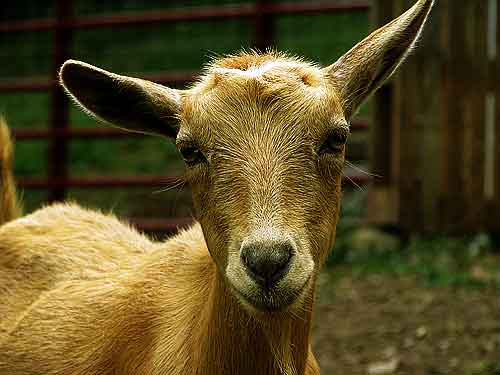
Thank you, Clover! You are so pretty!! Would you like a cookie?


Patty says:
What a wonderful and informative post! :cattail: You answered every question I could think of about milking a goat and dealing the the milk. Kudos to you for getting up and doing that every day. :sheepjump:
Do you have enough to make cheese yet? That is a great pic of the giant egg! I cannot wait til your hens start laying. :chicken: Still so much to look forward to!
On September 11, 2008 at 4:18 am
Cyndi B says:
I don’t have goats, but this was very interesting! Thanks for sharing the info.
As for that large egg…I hope it came from a large chicken. 😮
On September 11, 2008 at 7:02 am
wammy says:
We need to see a picture of that chicken…King Kong of the barnyard! Ouch! Maybe a little like giving birth to a set of twins that were almost 16 pounds. And the milking thing…you go girl. I am amazed!
On September 11, 2008 at 7:04 am
Carolyn A. says:
I knew it would get easier for you. All that prep work though. Wow! She actually looks like she’s smiling at you in that last picture. xxoo
On September 11, 2008 at 7:24 am
Heidi533 says:
Great post. I’m a visual learner too and this will be one post to refer back to when I get my goats.
OT: How do you manage to do all the things you do on the farm, maintain this site, write books and still keep your kitchen looking that clean?!
On September 11, 2008 at 7:50 am
Blaze says:
Well done!
Very nice visual guide to getting things done.
:thumbsup:
Though I can honestlys ay I have no intentions of milking a goat anytime soon, I at least have some idea what goes into it now!
On September 11, 2008 at 7:57 am
Lisa L says:
That was so interesting. I was curious as to how you ensured that everything was clean and sanitary. It is quite a thorough process but simple enough that anyone could do it. Thanks for the details. Lisa L.
On September 11, 2008 at 7:58 am
Tresha says:
Even in PICTURES you can sure tell how thick and creamy the milk is when it is FRESH! makes me want to pitch the store bought stuff I have now! What a process and a comittment from you every time you milk…but so worth it…
ok WHAT GIANT EGG??? I have gone back and searched every picure of this post like a Where’s Waldo book and I do not see eggs…are you city girls talking about that red tomato?? hahahaa…..
Tresh in Oklahoma
On September 11, 2008 at 8:04 am
Tresha says:
OOOOHHHHHH…..I just found Waldo! ha I see what I missed yesterday….”The Giant Egg in Comparison” post….bet you 100 bucks its a double yoker! how fun is that…bet that hen was a clucking and a belting out Amazing Grace after that lay!
Tresh
On September 11, 2008 at 8:07 am
Suzanne McMinn says:
Yes, the giant egg is in the Daily Farm Photo–you can click on it at the top of the sidebar and see the fullsize pic. My chickens aren’t laying yet–I had some eggs from Kathy-the-sheep-farmer. She told me the hen was a Black Star.
On September 11, 2008 at 8:16 am
Suzanne McMinn says:
Heidi, I do clean my kitchen a lot. It’s probably the cleanest room in the house. I cook a lot, so I have to keep it clean or I won’t have room to bake!
On September 11, 2008 at 8:17 am
Pamela-ATL. says:
I look forward to reading your daily posts. It’s always there first thing in the morning and it’s always something new and interesting.
Do you ever drink the goats milk? Or is it just used for baking purposes? How does it compare, taste wise, to cows milk? It looks so thick and creamy in your photos.
Also…loved Cole Dempsey’s Back in Town. How about another of your book give aways?
On September 11, 2008 at 8:26 am
Shari C says:
I have never lived on a farm and am amazed at the amount of work you go through for your goat milk. I have learned so much through your postings and continue to learn and enjoy life with your ‘gang’. I do know one thing for sure is you have to keep those cookies handy to keep everyone happy.
On September 11, 2008 at 8:26 am
Mental P Mama says:
That is waaay too much work for my lazy self. I am impressed with all the stuff you get done each and every day. Amazing.
On September 11, 2008 at 8:36 am
Crystal B. says:
I have learned a lot today. I did not know all that went into milking a goat and preserving the milk.
On September 11, 2008 at 8:37 am
Suzette says:
I always suspected there was more to this goat milking than just walking up and making a cookie offering. My hat is off to you! I’m not sure I’d be organized enough to tend to all those animals. And you write, too! Amazing.
On September 11, 2008 at 8:50 am
amy says:
Suzanne,
Great photo essay. Just one minor detail, raw milk laws vary state to state. In some states, it is legal to sell raw milk. Great job on your pictures!
On September 11, 2008 at 8:51 am
Suzanne McMinn says:
Thanks, Amy! I did get that wrong–just double-checked the Storey book and it says it is illegal to sell raw milk in “most states” but not all.
On September 11, 2008 at 8:56 am
Suzanne McMinn says:
Oh, I also wanted to say that I absolutely :heart: these old-fashioned glass milk bottles. Which I can’t possibly justify splurging on when I have perfectly good glass pint jars. Still. They are so adorable! Maybe someday….
https://www.lehmans.com/shopping/product/detailmain.jsp?itemID=6021&itemType=PRODUCT&RS=1&keyword=milk+bottles
On September 11, 2008 at 8:59 am
Abiga/karen says:
Thanks for the pictures as they definately do help me as I am visual also. I also would like to know if you have tasted it and what you think about it. We used to buy store bought goat milk many years ago when my first grandchild seemed to be allergic to cow’s milk. He drank it for a little while. I always thought it tasted funny but I have tried goat yogurt from a company in California and I love it. It does have a very very slight different taste but not enough to make it bad. Blessings.
On September 11, 2008 at 9:13 am
Suzanne, the Farmer's Wife says:
Great information Suzanne. The Farmer once worked for one of the largest dairy operations in the U.S. They were very, very careful about handling milk in a manufacturing setting, down to scrubbing the milk delivery trucks sparkling clean every day. Of course, the milk never touched the outside of the truck but clean is clean and think about what your perception would be of a filthy, dirty milk truck!
I’m so glad that you’ve finally got the milking thing down and you’re getting enough to use in baking. That’s great!! I’m waiting for some cheese making.
– Suzanne, the Farmer’s Wife
On September 11, 2008 at 9:18 am
Gizmo says:
GREAT post! I have some (time saving) milking goodies for you too.
I cool my milk the exact same way! The two tips I would give you is to not combine the milk into one freezer bag, and every bag of frozen milk. It can take up more space, but you want to know what milk is from what day. Should something show up in Clover’s milk, you’re able to track it back.
On September 11, 2008 at 9:35 am
Gizmo says:
OOPS….That should read – “date every bag of frozen milk.”
On September 11, 2008 at 10:16 am
Donna says:
I am not a milker..but that was INTERESTING! I enjoyed seeing the process! :sheepjump: Clover is so sweet!
On September 11, 2008 at 10:16 am
Kim W says:
Don’t you just LOVE those Storey books…they have something on EVERYTHING country! What a wealth of information.
BTW…thanks for visiting my humble blog.
Blessings from Ohio…
On September 11, 2008 at 10:26 am
Remudamom says:
When we were milking cows and goats we used it raw too. You are doing a great job, Clover and her babies are surely very happy under your care.
On September 11, 2008 at 10:40 am
Robin G. says:
So which states can you get raw milk in?
On September 11, 2008 at 11:42 am
J CopperCreekers says:
:shimmy: :clap: well done! I think we all are very proud of you and have teensy bit of envy also.
On September 11, 2008 at 11:46 am
Dava T. says:
Great, informative post Suzanne! Have you made goat butter yet? I’ll bet that would be yummy! :purr:
On September 11, 2008 at 1:46 pm
catslady says:
It’s surprising as to how many steps it takes to milk a goat!! Are you going to raise a black star some day? It must be a giant of a hen but what a great sized egg.
On September 11, 2008 at 2:46 pm
Susan says:
What a wonderfully informative post! I think you deserve a couple of cookies every morning, too. :thumbsup:
On September 11, 2008 at 2:59 pm
Brandy says:
Wow. A lot of work, but well worth it I’m sure. Thanks for the informative post.
On September 11, 2008 at 3:40 pm
vlyons says:
Very nice description of handling milk. I would only add that the bleach can dry out the skin of the teats, so a weekly application of udder balm keeps the skin nice and supple.
cheers, Virginia
On September 11, 2008 at 3:48 pm
Estella says:
Wonderful info, Suzanne!
On September 11, 2008 at 4:22 pm
Helen says:
I visited my grandma in Eastern Europe, and guess what – cruel people never let their goats feed the babies! They take them away first thing after birth (even if it means staying up all night). The kids then fed from a bottle, but the mothers DON’T FIGHT being milked. It is too late for pretty Clover, but you can try it with Nutmegg next year ?
On September 11, 2008 at 4:53 pm
sunnid755 says:
:bananadance: wow, I had NO idea all that was involved, I was filled with admiration before now, WOW.
On September 11, 2008 at 10:00 pm
Laura says:
What a great post i just came across your site and love it. We are planning to get sheep next spring and start our own little heard here in the Cevennes Mountains in France. But not having experience of looking after animals I am a little nervous as I want to make sure we do the best for them. We’ve pretty much got the kitchen gardens and polytunnel in place and are self sufficient in all our fruit and veg so our next step is animals we were thinking chickens and sheep/goats (about 4). Any advice for starting out.
On September 12, 2008 at 3:33 am
Alison says:
Robin, I know you can get it in California. I have seen it in our local organics market. They sell it in the old fashioned glass milk jugs. 🙂 :cowsleep:
On September 12, 2008 at 3:36 am
Gizmo says:
Robin and Alison,
California is the only state that allows raw milk to be sold to the public.
On September 12, 2008 at 10:37 am
Amy says:
It’s so cool that you’re getting milk! Yay! I can’t wait to read about the cheese-making.
On September 12, 2008 at 3:22 pm
MrsBurns says:
Robin, Alison and Gizmo:
I think the clarification is that CA is the only state allowing retail sales of raw milk (ie, at a grocery store). Several other states allow consumers to travel to a dairy farm and buy raw milk directly from a licensed farmer. Still other states have a certification/license called “pet milk”, which is just raw milk that can be fed to orphaned animals of any breed (or it can be fed to one’s family. :thumbsup: )
You could look at the Weston Price Foundation website; they keep a good list of what each state’s laws are and what states are playing political games with raw milk availability.
Thanks for the visual step-by-step. Very informative.
On September 13, 2008 at 10:25 pm
Krista says:
Great post! I wonder if it encourages or deters would-be goat owners? 😆 I’m assuming farms in the goat cheese business use mechanical milking methods? When are you making cheese
On September 15, 2008 at 11:48 am
jojo says:
LOVING the blog. yippee.. another goat blogger. i can’t find another can you? anyway, i was in your exact same shoes not just last year? or was it two. i fogget… i have enjoyed the kicking post, the hobble post, this post, ha… because i can laugh and say I KNOW I KNOW. I’m on my second year milking, babies are due in February.
Oh, the milk lasts much much longer than a week. it never goes bad like pastuerized milk, but will just start tasting a bit off. i can tell when it starts to separate in my coffee in the mornings. but heck, 2 weeks at least.
Welcome to goatdome!
jojo
On January 8, 2009 at 9:31 pm
Linda says:
I found your blog while looking for instruction for using vinegar to sanitize my milking equipment. Can you tell me where I could find such information?
I loved the tutorial! Very well done. It shows very well how to clean and disinfect before and after milking. I like the fact you said you are not an expert! Neither an I. I’m going to look over the rest of your blog now.
It looks like you have Nigerian’s as well! Very cool. I too have Nigerians.
On August 13, 2009 at 8:32 am
Suzanne says:
Hi, Linda! Yes, I do have Nigerians. They’re adorable! I don’t know anything about using vinegar to sanitize, I’m sorry.
On August 13, 2009 at 8:35 am
Nicolezmomma says:
I wouldn’t use Clorox near anything I eat or drink. It has dye and metals in it designed for cleaning clothes, not your insides. Look for bleach that has the NSF symbol (National Science Foundation), which is a mark of purity. You will get bleach and nothing else.
On April 22, 2010 at 7:08 am
EllyHood says:
I know this is an older post (so informative and so glad I found it!!!) and I’m not sure if you still do things the same way, but I wanted to mention that for sanitizing purposes bleach should be used with cool water, not hot. Hot water destroys the bleach (makes the chlorine break down), rendering it less potent. Happy milking!!! (It breaks my heart to see Clover’s sweet face and know that she isn’t around anymore. 🙁 )
On April 21, 2013 at 2:00 am